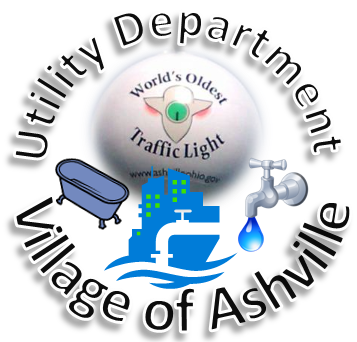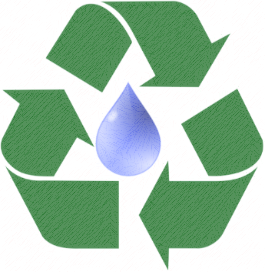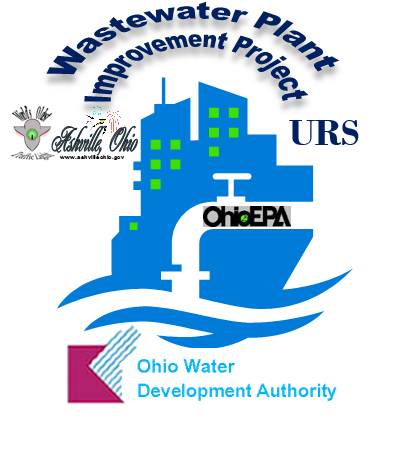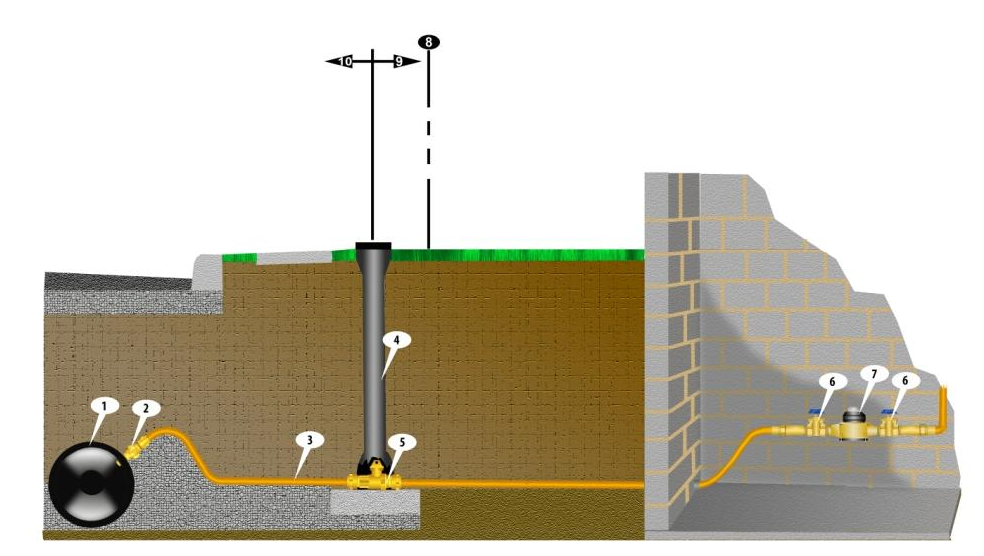
Ohio Environmental Protection Agency
Division of Drinking & Ground Waters
Village of Ashville Water Department
Annually, the Village of Ashville includes a report on the quality of water provided to our residents in our monthly newsletter. The Ohio Environmental Protection Agency (O-EPA) calls this the CCR or Consumer Confidence Report. All community public water systems are required to prepare a CCR and distribute this to their customers. The report contains information on the community's drinking water including the source of the water, contaminants detected, the likely sources of detected contaminants, health effects of the contaminants when violations occur, and availability of source assessments.
CCR's are required by the 1996 amendments to the Safe Drinking Water Act. The Federal Rule (40 CFR 141.151 through 155) was finalized in August 19, 1998. We hope this information will provide you comfort and security. We recognize that water quality is a very important area of operation.
The Village of Ashville pumped 223.709 gallons in 2015 with 14.858 removed in the process resulting in total finished pumped or 208.851 MG.
A Word from the Water Department
Starting August of 2015, the softeners at the water plant were rehabbed by replacing several valves, installing new meters, and programming work. This work was completed over three to four months and has allowed us to make the operation of the softeners more efficient resulting in salt and water conservation during the process. Also, in July we had an EPA inspection that went well with no major issues. Last year we began the process of connecting the water lines between Ashville and South Bloomfield for an emergency connection. The agreement was made and the work was finished earlier this year. This cooperation between the two municipalities will help secure both water systems and has opened the possibilities of more work together in the future. With several hydrants being replaced, all the softener work at the plant, and multiple projects around town in 2015, I am proud to say we have had very little to no interruption of service and zero violations.
In July of last year, the water department began the annual lead and copper monitoring for our distribution system. The results below show that there are no concerns for lead and copper concentrations. Also, in early 2016, the village took a proactive approach and doubled the amount of sampling required and completed another round of testing within the village. The same results being no elevated concentrations for lead or copper in the system.
If you have questions or any problems concerning the water or the water system, please feel free to contact me.
Introduction
The Ashville Water Department is pleased to provide you with this year’s Consumer Confidence Report. We want to keep you informed about the excellent water and services we have delivered to you over the past year. Our goal is, and has been to provide you a safe and dependable supply of drinking water. The treatment facility is located at 140 Park Street. The water treatment facility removes iron and manganese by oxidation and filtration. The filtered water is softened using an ion-exchange process. The softened water is disinfected with chlorine prior to distribution to our customer. The Village of Ashville’s Water Department has prepared the following report to provide information to you, the consumer, on the quality of our drinking water. Included within this report is general health information, water quality test results, how to participate in decisions concerning your drinking water and water system contacts.
We have been fortunate to have very few interruptions over the last year in our distribution system, such as large breaks resulting in loss of service. Last year we also installed a new chlorine feed system and overhauled our storage room. New tanks, ventilation, and piping were installed with an outside bulk feed line. These improvements make the delivery of chlorine significantly safer and more convenient.
If you have any questions, do not hesitate to contact the water department.
Thank you for your time.
Source Water Information
The Village of Ashville’s Water Department receives its drinking water from two (2) wells located at the village-owned and operated facility. A third (3rd) well is located south of the village on Viking Way. These wells obtain raw water from the Teays Valley Aquifer. Aquifers are porous underground formations (such as sand or gravel) that are saturated with water.
The Ohio Environmental Protection Agency has developed a program called Ohio's Source Water Assessment and Protection (SWAP) which is designed to protect our sources of drinking water. Through this program, the Ohio EPA has endorsed “the Delineation and Potential Contaminant Source Inventory components of the Village of Ashville’s drinking water source protection plan as meeting the requirements of the Ohio Wellhead Protection and Source Water Assessment and Protection Programs”. According to this study, the aquifer (water-rich zone) that supplies water to the Village of Ashville has a high susceptibility to contamination. This determination is based on the following:
- presence of a relatively thin protective layer of clay/shale/other overlying the aquifer,
- shallow depth (less than 50 feet below ground surface) of the uppermost aquifer, and
- presence of significant potential contaminant sources in the protection area.
This susceptibility means that under currently existing conditions, the likelihood of the aquifer becoming contaminated is relatively high. This likelihood can be minimized by implementing appropriate protective measures. More specifically this report identified seven (7) potential significant sources of contamination within the one year capture zones. They include: (1)sanitary sewer lines, (2,3,4) source wells, (5)natural gas line, (6) Ashville Park, and (7) municipal road maintenance. More information about the source water assessment or what consumers can do to help protect the aquifer is available by calling Tom Bouts, Jim Welsh, or Franklin Christman at 740-983-6367.
|
|
|
| 1. Water Main 2. Water Tap 3. Water Lateral 4 & 5. Curb Shut Off Valve 6, 7 & 8. Meter Set-up | |
Special Precaution Needs
Some people may be more vulnerable to contaminants in drinking water than the general population. Immuno-compromised persons such as persons with cancer undergoing chemotherapy, persons who have undergone organ transplants, people with HIV/AIDS or other immune system disorders, some elderly, and infants can be particularly at risk from infection. These people should seek advice about drinking water from their health care providers. EPA/CDC guidelines on appropriate means to lessen the risk of infection by Cryptosporidium and other microbial contaminants are available from the Safe Drinking Water Hotline (1-800-426-4791).
What are sources of contamination to drinking water?
The sources of drinking water, both tap water and bottled water, include rivers, lakes, streams, ponds, reservoirs, springs, and wells. As water travels over the surface of the land or through the ground, it dissolves naturally-occurring minerals and, in some cases, radioactive material, and can pick up substances resulting from the presence of animals or from human activity.
Contaminants that may be present in source water include: (A) Microbial contaminants, such as viruses and bacteria, which may come from sewage treatment plants, septic systems, agricultural livestock operations and wildlife; (B) Inorganic contaminants, such as salts and metals, which can be naturally-occurring or result from urban storm water runoff, industrial or domestic wastewater discharges, oil and gas production, mining, or farming; (C) Pesticides and herbicides, which may come from a variety of sources such as agriculture, urban storm water runoff, and residential uses; (D) Organic chemical contaminants, including synthetic and volatile organic chemicals, which are by-products of industrial processes and petroleum production, and can also come from gas stations, urban storm water runoff, and septic systems; (E) Radioactive contaminants, which can be naturally-occurring or be the result of oil and gas production and mining activities.
In order to ensure that tap water is safe to drink,
USEPA prescribes regulations which limit the amount of certain contaminants in water provided by public water systems. FDA regulations establish limits for contaminants in bottled water which must provide the same protection for public health. Drinking water, including bottled water, may reasonably be expected to contain at least small amounts of some contaminants. The presence of contaminants does not necessarily indicate that water poses a health risk. More information about contaminants and potential health effects can be obtained by calling the Environmental Protection Agency's Safe Drinking Water Hotline (1-800-426-4791).
Lead and Tier 3 Reporting
If present, elevated levels of lead can cause serious health problems, especially for pregnant women and young children. Lead in drinking water is primarily from materials and components associated with service lines and home plumbing. Village of Ashville’s Water Department is responsible for providing high quality drinking water, but cannot control the variety of materials used in plumbing components. When your water has been sitting for several hours, you can minimize the potential for lead exposure by flushing your tap for 30 seconds to 2 minutes before using water for drinking or cooking. If you are concerned about lead in your water, you may wish to have your water tested. Information on lead in drinking water, testing methods, and steps you can take to minimize exposure is available from the Safe Drinking Water Hotline or at http://www.epa.gov/safewater/lead.
Listed below is information on those contaminants that were found in the Village of Ashville’s Water Department:
|
Mean Hardness 215 mg/L |
|
Average Iron Content 0.33 mg/L |
| OH6500012 | ASHVILLE VILLAGE PWS | ||||||
| Contaminants (Units) | MCLG | MCL | Level Found | Range of Detections | Violation | Sample Year | Typical Source of Contaminants |
| Inorganic Contaminants | |||||||
| Chlorine Total (mg/L) | 4 | 4 | 0.96 | 0.46-1.36 | No | 2011 | Water Additive to Control Microbes. |
| Contaminants (Units) | MCLG | MCL | 90th Percentile | # of Samples over AL | Violation | Sample Year | Typical Source of Contaminants |
| Copper (ppm) | 1.3 | AL=1.3 | 0.13 | 1 | No | 2015 | Corrosion of Household Plumbing systems; Erosion of Natural deposits; Leaching from Wood Preservatives. |
| Lead (ppb) | 0 | AL=15 | <7 | 0 | No | 2015 | Corrosion of Household Plumbing systems; Erosion of Natural deposits; |
| None of the samples exceeded the lead Action Level (AL) of 15 (ppb) or Copper Action Level at 1.3 (ppm) | |||||||
| TTHMs (ppb) [Total Trihalomethane] |
No goal for the total |
80 | 8.4 | 7.83-8.4 | No | 2015 | By-product of drinking water chlorination. |
| HAAS (ppb) (Haloacitic Acid) | 0 | 60 | 2.2 | 1.4-2.2 | No | 2015 | By-product of drinking water chlorination. |
| Barium (ppm) | 2 | 2 | 0.0873 | .087-.087 | No | 2013 | Discharge of drilling wastes; Discharge from metal refineries; Erosion of natural deposits |
| Fluoride Total (ppm) | 4 | 4 | 1.21 | 1.21-1.21 | No | 2013 | Erosion of natural deposits; water additive which promotes strong teeth; discharge from fertilizer & aluminum factories. |
| Volatile Organic Contaminants | MCLG | MCL | Level Found | Range of Detections | Violation | Sample Year | Typical Source of Contaminants |
| Chloroform (ppm) | NA | NA | 0.00063 | .00100-.00100 | No | 2014 | By-product of drinking water chlorination. |
| OH6500012 | ASHVILLE VILLAGE PWS | |||||||
| Organic Disinfection Byproducts (DBPs) | Collection Date | Highest Level Detected | Range of Levels Detected | MCLG | MCL | Units | Violation | Likely Source of Contamination |
| Chloroform | 2015 | 3.13 | NA | ppb | No | Unregulated Contaminants | ||
| Bromodichloromethane | 2015 | 2.96 | NA | ppb | No | Unregulated Contaminants | ||
| Dibromochloromethane | 2015 | 2.00 | NA | ppb | No | Unregulated Contaminants | ||
| Detections of DBPs in raw water may be attributed to backflow of treated water, sampling from an incorrect location, or contamination in the source water. Consult the drinking water inspector in these situations | ||||||||
| Dibromoacetic acid | 2015 | 1.000 | NA | 60.0 | ppb | No | Unregulated Contaminants | |
|
Five Haloacetic Acids (HAAS): the sum of the concentrations of Monochloroacetic acid, Dichloroacetic acid, Trichloroacetic acid, Monobromoacetic acid and Dibromoacetic acid |
||||||||
About your drinking water:
The EPA requires regular sampling to ensure drinking water safety. The Ashville Water Department conducted sampling for {bacteria; inorganic; radiological; synthetic organic; volatile organic} during 2014. Samples were collected for a total of four (4) different contaminants most of which were not detected in the Ashville Water Department water supply. The Ohio EPA requires us to monitor for some contaminants less than once per year because the concentrations of these contaminants do not change frequently. Some of our data, though accurate, are more than one year old.
|
License to Operate (LTO) Information We have a current unconditional license to operate our water system.
|
Definitions of some terms contained within this report.
- Maximum Contaminant Level Goal (MCLG): The level of a contaminant in drinking water below which there is no known or expected risk to health. MCLGs allow for a margin of safety.
- Maximum Contaminant Level (MCL): The highest level of contaminant that is allowed in drinking water. MCLs are set as close to the MCLGs as feasible using the best available treatment technology.
- Parts per Million (ppm) or Milligrams per Liter (mg/L) are units of measure for concentration of a contaminant. One ounce in 7,350 gallons of water. A part per million corresponds to one second in a little over 11.5 days.
- Parts per Billion (ppb) or Micrograms per Liter (μg/L) are units of measure for concentration of a contaminant. One ounce in 7,350,000 gallons of water. A part per billion corresponds to one second in 31.7 years.
- Action Level (AL): The concentration of a contaminant which, if exceeded, triggers treatment or other requirements which a water system must follow.
- Action Level Goal (ALG): The level of contaminant in drinking water below which there is no known or expected risk to health. ALGs allow for a margin of safety.
- Maximum Residual Disinfectant Level Goal (MRDLG): The level of drinking water disinfectant below which there is no known or expected risk to health. MRDLGs do not reflect the benefits of the use of disinfectants to control microbial contaminants.
- Maximum Residual Disinfectant Level (MRDL): The highest level of a disinfectant allowed in drinking water. There is convincing evidence that addition of a disinfectant is necessary for control of microbial contaminants.
- Million Fibers per Liter (MFL) millirems per year (mrem/year)pico Curies per liter is a measure of radioactivity = pCi/L.
- The “<“ symbol: A symbol which means less than. A result of <5 means that the lowest level that could be detected was 5 and the contaminant in that sample was not detected.
Vulnerability Assessment Report
Ohio EPA recently completed a study of the Village of Ashville's source of drinking water to identify potential contaminant sources and provide guidance on protecting the drinking water source. According to this study, the aquifer (water-rich zone) that supplies water to the Village of Ashville has a high susceptibility to contamination. This determination is based on the following:
- Presence of a relatively thin protective layer of clay/shale/other overlying the aquifer,
- shallow depth (less than 50 feet below ground surface) of the uppermost aquifer, and
- presence of significant potential contaminant in the protection area.
a This susceptibility mean that under currently existing conditions, the likeihood of the aquifer becoming contaminated is relatively high. This likelihood can be minimized by implementing appropriate protective measures. More information about the source water assessment or what consumers can do to help protect the aquifer is available by calling James Welsh or Franklin Christman at (740) 983-6367.
How do I participate in decisions concerning my drinking water?
We want our valued customers to be informed about their water utility. If you want to learn more, please attend our regularly scheduled Village Council meetings. They are held at 6:30 P.M. on the first and third Monday of each month at 200 East Station Street.
For more information on your drinking water contact James Welsh or Franklin Christman (740) 983–6367.
We are pleased to report that our drinking water is safe and meets federal and state requirements. This report shows your water quality and what it means. Drinking water, including bottled drinking water, may be reasonably expected to contain at least small amounts of some contaminants. The presence of these contaminants does not necessarily indicate that water poses a health risk. Thank you for allowing us to continue providing your family with clean and quality drinking water this year.
Past Consumer Confidence Reports
|
For more month to month and annual utility department information click on the image to the right to access the Utility Department Report. This is also available on the home page at the bottom, using the same image. |
 |
|
For the Special Environmental Projects (SEP's) completed in 2014 click on the the image to the right to access that information. This is also available on the home page within the slide show, using the same image. |
 |
|
For the information about the Water Resources Recovery Facility (WRRF) click on the image to the right to access that information. This is also available on the home page within the slide show, using the same image. |
 |


